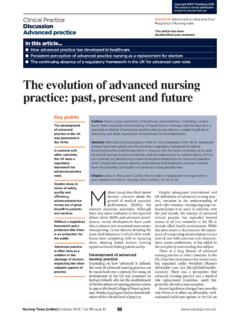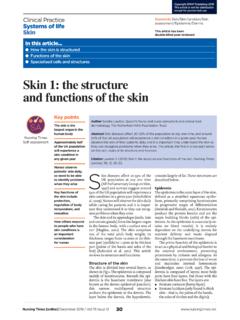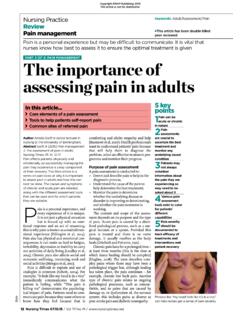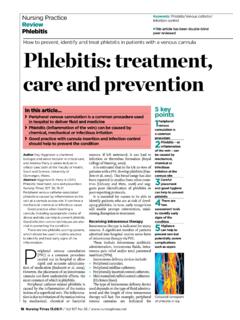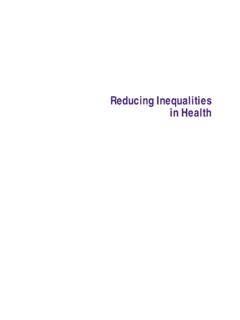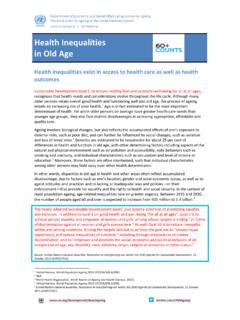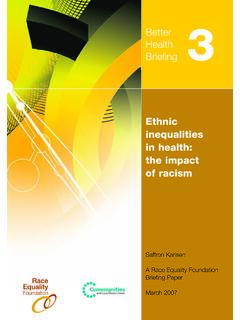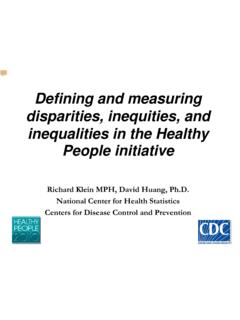Transcription of The impact of ethnicity on health inequalities - EMAP
1 18 Nursing Times / Vol 111 No 44 / : ethnicity /Racism/Sociology/Wellbeing This article has been double-blind peer reviewedAuthor David Matthews is lecturer, health and social care, Coleg Llandrillo, Rhos on Matthews D (2015) Sociology in nursing 4: the impact of ethnicity on health inequalities . Nursing Times; 111: 44, is a complex, sensitive subject that deserves greater attention if we are to achieve health equality for the population. Minority ethnic groups generally have poorer health than the general population, but the reasons are many and much debated. This article explores the impact of ethnicity on health and wellbeing.
2 The impact of ethnicity on the social distribution of health has been recognised as a serious issue since the 1970s (Karlsen and Nazroo, 2000). Evidence from research shows that, on average, individuals from black and minority ethnic backgrounds dis-play greater levels of poor health than the general population (Barry and Yuill, 2011). While the reasons for this are contested, sociology rejects biological and genetic interpretations due to the lack of evidence and the limitations of such assumptions (Nazroo and Williams, 2006) and, instead, social and economic inequalities are said to be the main causes of this disparity (Karlsen and Nazroo, 2011).
3 ethnicity and raceBefore investigating the causes of health inequalities between different ethnic groups, it is necessary to separate the con-cept of ethnicity from race. The terms are often used interchangeably but race is dif-ferent and of little analytical use. Race 5 key points 1 People from minority ethnic groups generally have poorer health than the rest of the population 2 ethnicity should not be confused with race, which is a different concept and of little analytical use3 ethnicity is based on social, cultural and historical variations 4 There are geographical health inequalities among minority ethnic groups.
4 With London displaying the greatest disparities5 Research suggests that socioeconomic inequality is the key factor in the health disparities experienced by minority ethnic groupswas often used in the past to argue the existence of biological differences between global populations (Box 1), but this posi-tion is discredited there is no evidence to justify dividing populations along biolog-ical grounds (Bartley, 2004). Global population groups may be char-acterised as possessing certain genes, but these predominantly influence hair, eye and skin colour, and are of little impor-tance in predicting susceptibility to dis-ease (Bartley, 2004).
5 Different population groups have more biological and genetic commonalities than differences; varia-tions that do exist are no greater than those in a single population group (White, 2013). Race reduces health disparities to bio-logical factors, thereby marginalising the social forces that are overwhelmingly the main causes for health inequalities among different groups. Focusing on race directs attention at individuals rather than unequal social relationships that cause ill ethnicityMore recent research into the distribution of health has centred on ethnicity rather than race, but defining ethnicity is complex (Mason, 2000).
6 Broadly, it refers to the iden-tification of population groups based on social, cultural and historical variations. Ethnic groups are characterised by organ-ised cultural boundaries such as language, religion and country of origin (Platt, 2006). ethnicity is a subjective concept, com-prising both self-identification and cate-gorisation (Mason, 2000). Individuals can recognise themselves as belonging to a particular group, with their perception of their own ethnicity influenced by the way In this health challenges facing minority ethnic groups Issues concerning racism How to define ethnicityAs part of a series exploring the socioeconomic influences on health and wellbeing, this article focuses on ethnicity and its contribution to health inequalities in societyThe impact of ethnicity on health inequalitiesMinority ethnic groups may experience poorer health than the majority population PART 4 of 5.
7 SocIoLogy IN NuRSINg Nursing PracticeReview SociologyCopyright EMAP Publishing 2015 This article is not for / Vol 111 No 44 / Nursing Times 19the 1990s, Nazroo (2004) concluded there was a strong relationship between socioeco-nomic status and the health of all ethnic minorities as, once the impact of socioeco-nomic status was removed, the risk of poor health fell. Evidence from the US supports this, with high-income white and black groups displaying better health than lower-income counterparts (Williams, 2012).While socioeconomic status has a sig-nificant impact , when factors accounting for this are adjusted, there remain health disparities between minority ethnic groups and the ethnic majority.
8 When the health status of individuals in both groups in the same socioeconomic position are compared, individuals from minority ethnic groups still display poorer health . As Nazroo (2004) argued, there is another component of ethnicity that increases the susceptibility of ethnic minorities to poor health : accounting for this other factor is not simple and various causes have been identified one of which is racial prejudice and racism (Annandale, 2014). The impact of racismThe extent of racial prejudice in Britain is difficult to quantify, primarily because people may be unwilling to admit to it.
9 However, the British social attitudes survey in 2013 showed that 30% of the British pop-ulation described themselves as racially prejudiced (National Centre for Social Research, 2014). Direct experience of racial prejudice, or awareness that such attitudes exist, can have significant negative conse-quences for individuals health , particu-larly their mental health (Annandale, 2014; Barry and Yuill, 2011). Karlsen et al (2005) argued that experiencing racial prejudice increases the risk of anxiety disorders and depression, as it has among Caribbean, Indian, Pakistani and Irish minorities.
10 Similarly, racially prejudiced attitudes can be embedded in how society operates, causing social structures and institutions to function in a racist manner. Rather than just focusing on the actions of individuals, we need to look at social structures and institutions that may operate in a are 30% more likely than white women to report a long-term illness versus 15% for Britain as a whole. Mental health studies show that Afro-Caribbeans display higher levels of depres-sion and rates of schizophrenia than the majority of the population (Rogers and Pil-grim, 2014).


